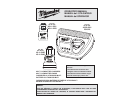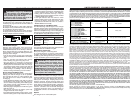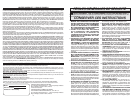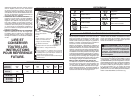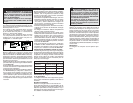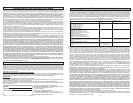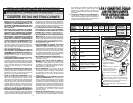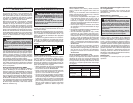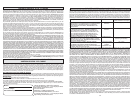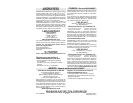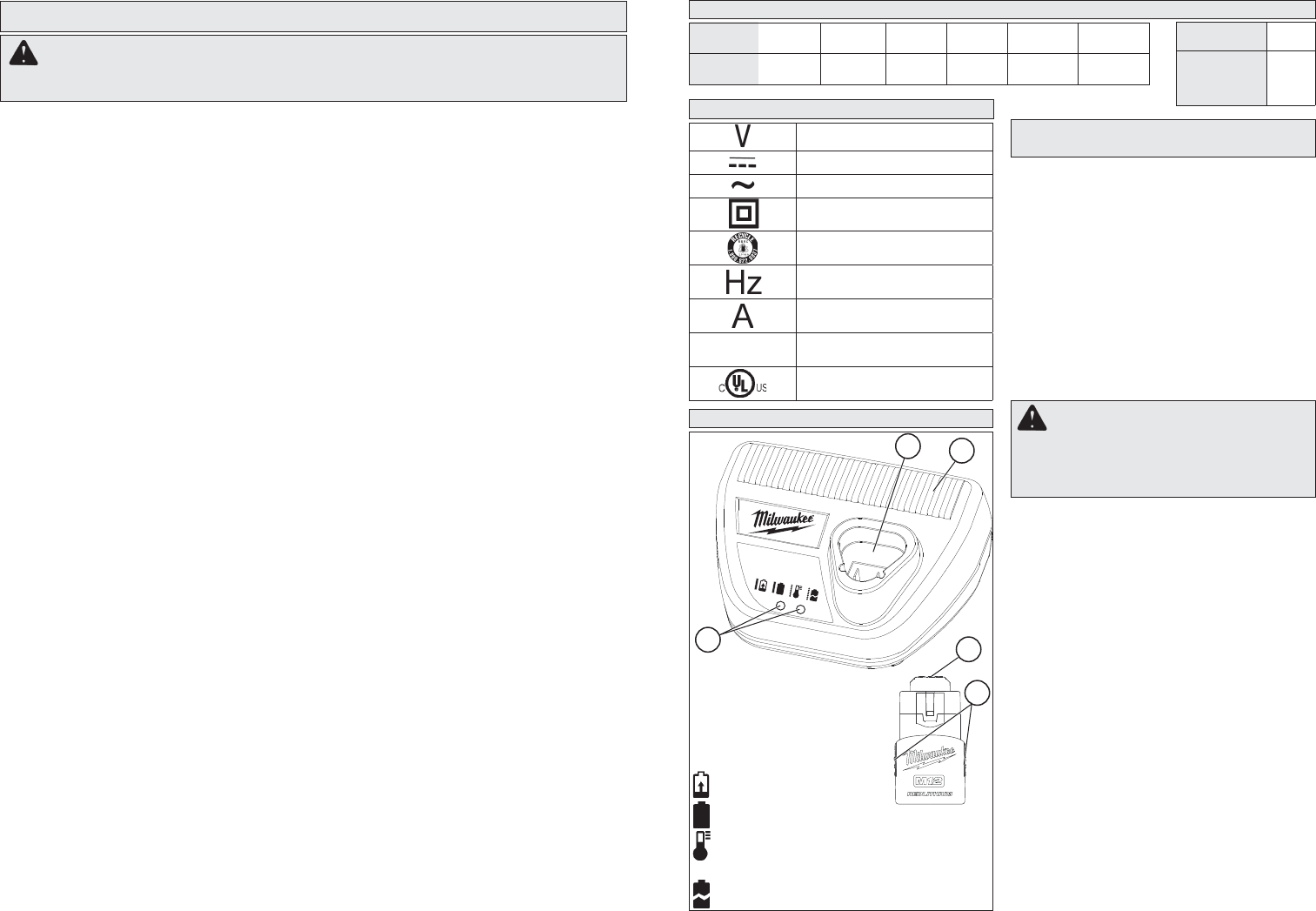
2
3
WARNING READ AND UNDERSTAND ALL INSTRUCTIONS. Failure to follow all
instructions listed below, may result in electric shock, fi re and/or serious personal injury.
SAVE THESE INSTRUCTIONS
9. CHARGER 48-59-2401 IS RATED FOR 120
VOLT AC ONLY. CHARGER 2510-20 IS RATED
FOR 12 VOLT DC AND 120 VOLT AC. Charger
must be plugged into an appropriate receptacle.
10. USE ONLY RECOMMENDED ATTACHMENTS.
Use of an attachment not recommended or sold
by the battery charger or battery pack manufac-
turer may result in a risk of fi re, electric shock
or personal injury.
11. UNPLUG CHARGER when not in use. Remove
battery pack from unplugged chargers.
12. TO REDUCE THE RISK OF ELECTRIC
SHOCK, always unplug charger before clean-
ing or maintenance. Do not allow water to fl ow
into AC/DC plug. Use a Ground Fault Circuit
Interrupter (GFCI) to reduce shock hazards.
13. DO NOT BURN OR INCINERATE BATTERIES.
Batteries may explode, causing personal injury
or damage. Toxic fumes and materials are cre-
ated when batteries are burned.
14. DO NOT CRUSH, DROP, OR DAMAGE batter-
ies. Do not use a battery pack or charger that
has received a sharp blow, been dropped, run
over, or damaged in any way (e.g., pierced with
a nail, hit with a hammer, stepped on).
15. DO NOT DISASSEMBLE. Incorrect reassembly
may result in the risk of electric shock, fi re or
exposure to battery chemicals. If it is damaged,
take it to a MILWAUKEE service facility.
16. BATTERY CHEMICALS CAUSE SERIOUS
BURNS. Never allow contact with skin, eyes, or
mouth. If a damaged battery pack leaks battery
chemicals, use rubber or neoprene gloves to
dispose of it. If skin is exposed to battery fl uids,
wash with soap and water and rinse with vin-
egar. If eyes are exposed to battery chemicals,
immediately fl ush with water for 20 minutes and
seek medical attention. Remove and dispose of
contaminated clothing.
17. DO NOT SHORT CIRCUIT. A battery pack will
short circuit if a metal object makes a connection
between the positive and negative contacts on
the battery pack. Do not place a battery pack
near anything that may cause a short circuit,
such as coins, keys or nails in your pocket. A
short circuited battery pack may cause fi re and
personal injury.
18. STORE YOUR BATTERY PACK AND CHAR-
GER in a cool, dry place. Do not store battery
pack where temperatures may exceed 120°F
(50°C) such as in direct sunlight, a vehicle or
metal building during the summer.
1. SAVE THESE INSTRUCTIONS - THIS OP-
ERATOR’S MANUAL CONTAINS IMPORTANT
SAFETY AND OPERATING INSTRUCTIONS
FOR MILWAUKEE M12™ LI-ION BATTERIES
AND THE MILWAUKEE M12™ LI-ION BAT-
TERY CHARGER.
2. BEFORE USING THE BATTERIES AND CHAR-
GER, READ THIS OPERATOR’S MANUAL,
YOUR TOOL OPERATOR’S MANUAL, AND
ALL LABELS ON THE BATTERY PACK,
CHARGER AND TOOL.
3. CAUTION! TO REDUCE THE RISK OF INJURY,
CHARGE MILWAUKEE M12™ LITHIUM-ION
BATTERIES ONLY IN MILWAUKEE M12™
LITHIUM-ION CHARGERS. Other types of char-
gers may cause personal injury or damage. Do
not wire a battery pack to a power supply plug or
car cigarette lighter. Batteries will be permanently
disabled or damaged.
4. USE MILWAUKEE M12™ LITHIUM-ION
BATTERIES ONLY ON MILWAUKEE M12™
LITHIUM-ION TOOLS. Use with other tools may
result in a risk of fi re, electric shock or personal
injury.
5. AVOID DANGEROUS ENVIRONMENTS. Do
not charge battery pack in rain, snow, damp or
wet locations.
Do not use battery pack or char-
ger in the presence of explosive atmospheres
(gaseous fumes, dust or fl ammable materials)
because sparks may be generated when insert-
ing or removing battery pack, possibly causing
fi re.
6. CHARGE IN A WELL VENTILATED AREA.
Do not block charger vents. Keep them clear to
allow proper ventilation. Do not allow smoking
or open fl ames near a charging battery pack.
Vented gases may explode.
7. MAINTAIN CHARGER CORD. When unplug-
ging charger, pull plug rather than cord to reduce
the risk of damage to the electrical plug and cord.
Never carry charger by its cord. Keep cord from
heat, oil and sharp edges. Make sure cord will
not be stepped on, tripped over or subjected
to damage or stress. Do not use charger with
damaged cord or plug. Have a damaged cord
replaced immediately with identical replacement
parts (see “Maintenance”).
8. DO NOT USE AN EXTENSION CORD UNLESS
IT IS ABSOLUTELY NECESSARY. Using the
wrong, damaged or improperly wired extension
cord could result in the risk of fi re and electrical
shock. If an extension cord must be used, plug
the charger into a properly wired 16 gauge or
larger extension cord with pins that are the
same number, size and shape as the pins on
the charger. Make sure that the extension cord
is in good electrical condition.
READ AND SAVE ALL
READ AND SAVE ALL
INSTRUCTIONS FOR
INSTRUCTIONS FOR
FUTURE REFERENCE.
FUTURE REFERENCE.
FUNCTIONAL DESCRIPTION
SYMBOLOGY
Volts
Direct Current
Alternating Current
Double Insulated
Properly Recycle Batteries
Hertz
Amps
mA
Milliamps
Underwriters Laboratories, Inc.
United States and Canada
4
5
3
2
1
IMPORTANT SAFETY INSTRUCTIONS
MILWAUKEE 12 V LITHIUM-ION
BATTERY PACKS
Maintenance and Storage
Do not expose your battery pack or cordless tools
to water or rain, or allow them to get wet. This could
damage the tool and battery pack. Do not use oil
or solvents to clean or lubricate your battery pack.
The plastic casing will become brittle and crack,
causing a risk of injury.
Store batteries at room temperature away from
moisture. Do not store in damp locations where
corrosion of terminals may occur. As with other bat-
tery types, permanent capacity loss can result if the
battery pack is stored for long periods of time at high
temperatures (over 120° F). MILWAUKEE Lithium-
Ion batteries maintain their charge during storage
longer than other battery types. After about six
months of storage, charge the battery pack as
normal.
1. Contacts
2. Release buttons
3. Vents
4. Bay
5. Light indicators - when a
battery pack is inserted into the
charger, the light will indicate
the following situations:
Continuous red: Charging
Continuous green: Charging complete
Flashing red: Battery pack is too hot/cold-
Charging will begin when battery
reaches correct charging temperature
Flashing red/green: Damaged or faulty battery pack
SPECIFICATIONS
Charger
Cat. No.
48-59-2401
2510-20
AC Input
Volts
120
120
AC Input
Milliamps
750
750
DC Output
Volts
12 DC
12 DC
DC Output
Amps
3
3
DC Input
Volts
- -
12
DC Input
Amps
- -
4.4
WARNING To reduce the risk of in-
jury or explosion, never burn or incinerate
a battery pack even if it is damaged, dead or
completely discharged. When burned, toxic
fumes and materials are created.
Disposing of MILWAUKEE Lithium-Ion Batteries
MILWAUKEE Lithium-Ion batteries are more en-
vironmentally friendly than some other types of
power tool batteries (e.g., nickel-cadmium). Always
dispose of your battery pack according to federal,
state and local regulations. Contact a recycling
agency in your area for recycling locations.
Even discharged batteries contain some energy.
Before disposing, use electrical tape to cover the
terminals to prevent the battery pack from shorting,
which could cause a fi re or explosion.
RBRC Battery Recycling Seals
The RBRC™ Battery Recycling Seals (see "Sym-
bology") on your tool battery pack indicates that
MILWAUKEE has arranged for the recycling of
that battery pack with the Rechargeable Battery
Recycling Corporation (RBRC). At the end of your
battery pack's useful life, return the battery pack to
a MILWAUKEE Branch Offi ce/Service Center or the
participating retailer nearest you. For more informa-
tion, visit the RBRC web site at www.rbrc.org.
Battery
Cat. No.
DC
Volts
48-11-2401
48-11-2420
48-11-2402
48-11-2440
12
12
12
12



